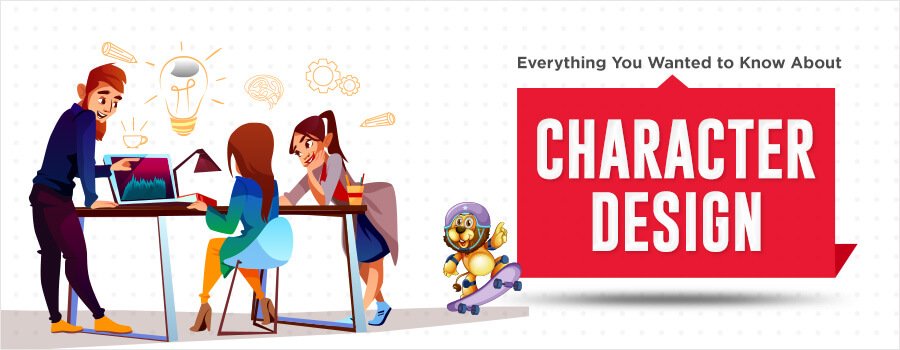Character Design: What is it?
All of us have grown up watching cartoon movies and animations. At some point of time or other, we all have developed a fancy of cartoon characters. The larger than life characters may showcase wild moves, hold superpowers, or simply charmed us with their innocent maneuvers. The bond we had developed has never faded away. The reason for developing an affinity for these characters was that we tried to be like time.
Characters are these digital or handcrafted beings that we see on screen or within comic books. The success of a strong character depends on the appeal it generates among audiences. Characters become immortal when viewers can relate to them. Character design essentially implies bestowing a unique personality to the created character. The behavioral pattern is demonstrated by the way the character interacts with its surrounding while walking, talking, looking or thinking.
Memorable characters are loved by us all. Evil or friendly, smart looking or distorted, comical or stern; characters are immortalized by their personalities. The emotions which are reflected from the characters are the result of hard work put in by designers and artists. The time invested by artists to attentively mold the looks, motion, mannerisms of characters enchant audiences. Either in movies or in games, the peculiarities of the character keeps the viewers or players engrossed.
In short, character design involves a set of processes. Characterization is the process of bestowing unique personality to the character with which audiences can relate to. Character creation involves designing the looks, intuitive response mechanism and mannerisms of the character as per the conditions where they would be deployed. The look, poses, and gesticulations of the animated character are standardized through Model Sheet documentation.
Character Sketches: Their Importance
To make the characters express themselves purposefully and impulsively, character sketching has a major role to play. You can start with the character’s written outline. This facilitates ease of brainstorming and subsequently helps in organizing the physical characteristics of shape, size, height, eyes, nose etc. The outline can also carry information about non-physical traits of character like emotive quotient, mannerism, personality, backdrop, history, preferences, etc.
Character sketches seamlessly blend the physical and non-physical attributes in the form of outlines. Embodiment of these characteristics during the outlining process can enhance the quality of visual sketch. You can also draw more inspiration by looking at the outline. You can follow your impulses and sketch out the things that come to your mind or strike your imagination. The same can be refined later on. If the objective of character designing is already clear to you, then the process will deliver offer satisfactory outcomes. Characters can be drawn with better aesthetics and strong personalities.
Different Types of Characters
When you get down to character drawing, you can build the characters in 2D (two dimensional) or 3D (three dimensional). It can be sculpted with hand as done conventionally or can be modeled with computer software.
Guidelines for Designing Characters
You must have realized by now that a character has to be attentively designed. It would not appear out of thin air. For this, you need to follow some proven principles which would help in rendering your character successful.
Industries where character designing is used
Different creative industries extensively use 2D characters. Despite the surging popularity of 3D characters, these industries do use 2D designs widely. The industries that prominently use character design include cartoon makers, anime video producers, video games manufacturers, and feature films’ directors. 2D characters are significantly used because they are flexible to use and deploy as well as are compatible with large number of platforms. Multimedia, television, entertainment, video broadcasting and other industries use character designing largely. You can frequently spot 2D characters over the television.
On television, you must have come across numerous shows where 2D characters have been used exhaustively. The list of such programs is endless. Some shows that have gained international popularity include Avatar, The Simpsons, Archie’s etc. 2D character designs are also used in Japanese anime series which are motivated by manga comics. Majority of films which have gained critical acclaim and have influenced the thought process of generations have used 3D or 2D character designs in various manners. Some of such movies include Snow White and the 7 Dwarves, The Lion King etc. The lead has always been taken by Disney, the production house which had pioneered character animations and released many widely appreciated films.
In contemporary video games, movies, cartoon shows etc., 3D character design is popularly used.
Role of A Character Designer
The character designer is an artist who is responsible for conceptualizing the character, adding attributes and mannerisms to it, designing its form and shape, styling its physical and non-physical looks, and tweaking it as per demands of the project. To render the character’s physical appearance visually attractive, the designer aligns its personality with shape. The character, whether it be human or fictitious, needs to be carefully created from scratch and the process draws heavily on the creative energy of artists.
Artists aspiring to make their mark in the 3d modeling and animation industries must understand the intricacies of character designing. The design procedure essentially begins with character briefing.
By designing character, the artist give vent to his power of imagination and creativity. By diving deeper, the designer builds a character step by step to match the purpose and description. 3D artists model and rig the characters which have to be deployed in video games and 3D films. If the character is being developed for 2D animation project, then storyboard artist would look at it to ensure that it can complement the project’s script. The visual development artist would additionally develop more ambient details like house, vehicle etc. to highlight the character’s maneuvers.
You need to admit the fact character designing is a difficult work. It is a complicated process. Lots of practice is needed to perfect your designing and artistic skills. Sufficient industry exposure is needed to orient the behavioral patterns of characters as per the need of project.
Conclusion
If you aspire to learn more about character designing, you can get in touch with us. WinBizSolutionsIndia is a leading name in the domain of character design and animation services.




